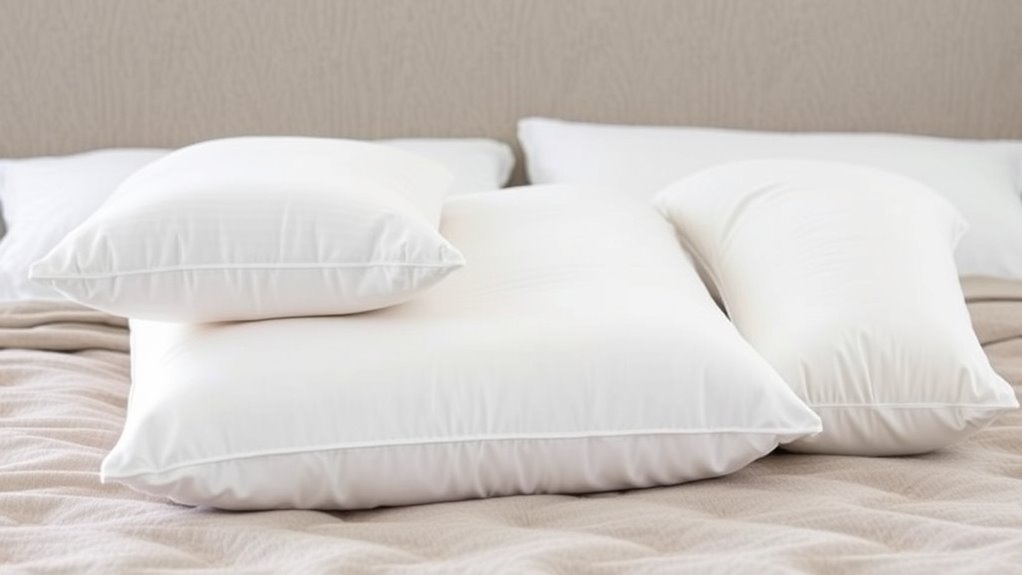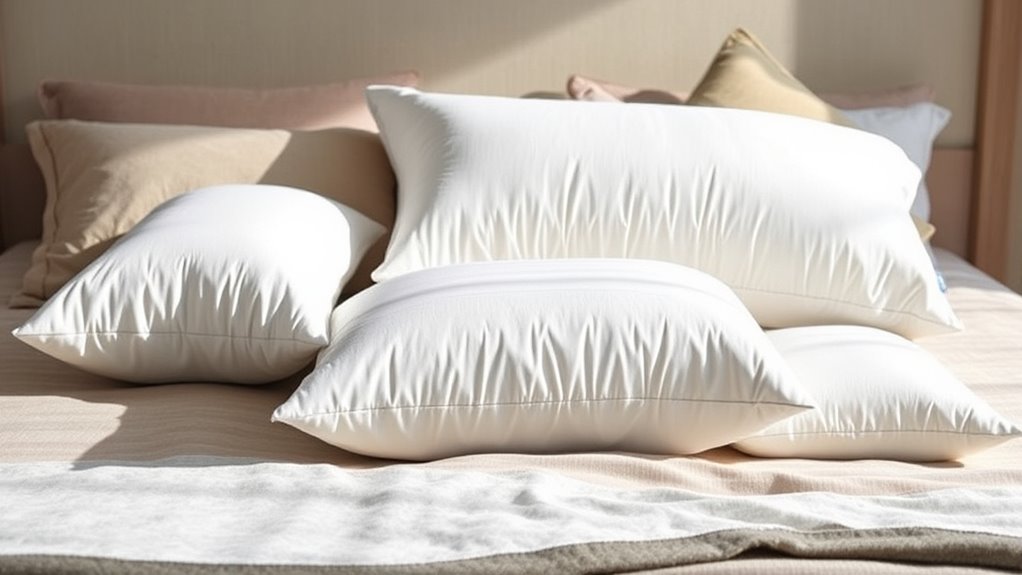Choosing the right pillow depends on your sleep position to guarantee proper support and comfort. Side sleepers should opt for firm pillows made of memory foam or latex to keep your neck aligned. Back sleepers benefit from medium-firm options that support your neck and shoulders gently. Stomach sleepers need soft, lightweight pillows to prevent strain. To find your best match, test different styles while lying in your usual sleep position. Keep exploring for expert tips to improve your sleep quality.
Key Takeaways
- Match pillow firmness and material to your sleep position: firm for side, medium for back, soft for stomach sleepers.
- Test pillows in your usual sleep posture to assess support, comfort, and spinal alignment.
- Side sleepers should choose supportive, high-loft pillows like memory foam or latex for neck stability.
- Back sleepers benefit from medium firmness pillows that support neck and shoulders without stiffness.
- Stomach sleepers need thin, soft pillows made of lightweight materials to minimize neck strain.
Understanding the Needs of Different Sleep Positions

Your sleep position considerably influences the type of pillow that will keep your neck aligned and comfortable. For side sleepers, look for pillows made from supportive materials like memory foam or latex that maintain a firm yet cushioning feel, ensuring your head and neck stay aligned with your spine. Back sleepers benefit from pillows with an ergonomic design that offers gentle support to the neck and upper shoulders, often using softer pillow materials like down or adjustable fill. Stomach sleepers require a thinner pillow with minimal loft, preferably made of lightweight materials to prevent neck strain. Understanding these needs helps you select a pillow that provides ideal support based on your sleep position, helping you wake up refreshed and free from discomfort.
Features to Look for in a Pillow for Each Sleep Style

Choosing the right pillow involves focusing on features that support your specific sleep style. Your pillow’s firmness and material choices are key. Side sleepers benefit from medium to firm pillows that maintain neck alignment, while back sleepers prefer medium firmness for support without stiffness. Stomach sleepers need softer pillows to prevent neck strain. To optimize your sleep comfort, consider how the pillow’s support level aligns with your preferred position and overall sleep quality.
Tips for Testing and Choosing the Perfect Pillow

To find the perfect pillow, start by testing different options in a natural setting, such as lying down in your usual sleep position. Pay attention to pillow firmness—whether you prefer soft, medium, or firm—as it impacts support and comfort. Try out various materials like memory foam, latex, or polyester, based on your material preferences, to see how they feel against your skin and how they support your head and neck. Take note of how your shoulders and neck feel after a few minutes; you want a pillow that maintains proper alignment. Don’t rush the process. Testing pillows in your typical sleep environment helps you identify which combination of firmness and material provides the best support for restful, pain-free sleep. Additionally, understanding the importance of sleep posture can guide you in choosing a pillow that promotes healthy spinal alignment.
Frequently Asked Questions
How Often Should I Replace My Sleeping Pillow?
You should replace your pillow every 1 to 2 years for ideal pillow longevity. Regularly inspect it for signs of wear, such as flattened or lumpy areas, and stains or odors. Follow these replacement tips to maintain proper support and hygiene. Remember, a fresh pillow helps improve sleep quality and prevents allergies. Don’t wait too long—your comfort and health depend on timely pillow replacement.
Are Memory Foam Pillows Suitable for All Sleep Positions?
Think of a memory foam pillow as a loyal guardian, molding to your unique shape. Memory foam benefits include excellent support and pressure relief, making it suitable for many sleep positions. However, pillow material differences matter: some find it too firm or retain heat. While versatile, it may not be ideal for stomach sleepers who prefer softer, more responsive pillows. Consider your comfort and sleep style when choosing this adaptable, yet nuanced, pillow material.
Can Using the Wrong Pillow Cause Chronic Neck Pain?
Using the wrong pillow can definitely cause chronic neck pain. Poor pillow ergonomics can lead to misaligned neck and spine, which strains muscles and nerves over time. If your pillow doesn’t support proper neck alignment, you might wake up with stiffness, soreness, or persistent discomfort. To avoid this, choose a pillow that maintains natural neck curvature and supports your sleeping position, promoting better neck health and reducing pain.
Do Pillow Materials Affect Allergy Sufferers Differently?
Think of pillow materials as a garden of possibilities, each with its own impact on your allergies. Hypoallergenic materials and allergy-friendly fabrics act like a shield, preventing allergens from sneaking in. If you’re sensitive, choosing these options helps you breathe easier and sleep peacefully. They’re designed to minimize allergy triggers, making your sleep environment a safe haven. So, yes, pillow materials can considerably affect allergy sufferers, shaping your nightly comfort.
How Do I Maintain and Clean My Sleep Pillow Properly?
To maintain your sleep pillow properly, prioritize good pillow hygiene by regularly washing and replacing it. Follow cleaning tips like checking care labels, using gentle detergents, and drying thoroughly to prevent mold and allergens. You should wash pillowcases weekly and consider replacing your pillow every 1-2 years for ideal support and cleanliness. These steps help keep your sleep environment fresh, comfortable, and allergen-free.
Conclusion
Choosing the right pillow truly makes a difference in your sleep quality. For example, imagine a back sleeper switching to a supportive, adjustable pillow and waking up refreshed—pain-free and energized. By understanding your sleep position and testing different options, you can find that perfect fit. Don’t settle for discomfort—invest time in selecting your ideal pillow. It’s a small change that can lead to big improvements in how you rest and feel every day.









